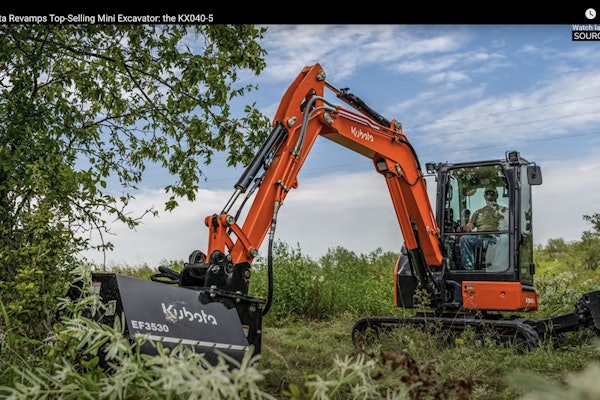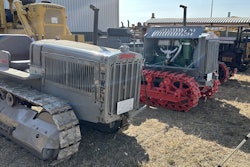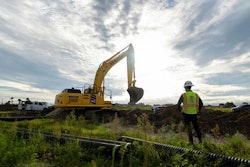Hampered by insufficient information,inadequate training and unprepared owners, officers face a host of frustrations when trying to recover stolen equipment
By Marcia Gruver
To determine if a machine is stolen, law enforcement first has to find its rightful owner. This is trickier than it first appears.
 The foremost line of defense is the Product Identification Number – or serial number – located on the machine. PINs used by construction equipment manufacturers, however, have their own frustrations. Since 2001, there’s been an international advisory calling for a standard 17-character PIN on all construction equipment. Such a PIN would put law enforcement on familiar ground since officers deal daily with automotive 17-character Vehicle Identification Numbers.
The foremost line of defense is the Product Identification Number – or serial number – located on the machine. PINs used by construction equipment manufacturers, however, have their own frustrations. Since 2001, there’s been an international advisory calling for a standard 17-character PIN on all construction equipment. Such a PIN would put law enforcement on familiar ground since officers deal daily with automotive 17-character Vehicle Identification Numbers.
To date, however, just a few manufacturers have adopted this 17-character PIN (for a more thorough discussion on manufacturer efforts, see the article on page 60). Because there’s no consistency – PINs placed on construction equipment can be five to 17 characters long – there’s currently no way for law enforcement computers to determine if a number has been entered correctly. If it hasn’t, the chances are zero a patrol officer checking a suspicious machine at 1 a.m. will find it listed as stolen.
In addition, there are thousands of PIN location variations in existence and new ones get created each year. This makes it impossible to produce a list that is both easy for police to carry and up to date, according to the International Association of Chiefs of Police. For example, PIN locations on skid steers can be found in at least four general locations.
The PIN is ideal, but any number will help, including owner-applied numbers. Some components, usually engines and transmissions, have their own serial numbers, which sometimes can be cross referenced to locate a machine’s owner.
YES, BUT THEY STILL NEED TO BE FOUND
Of course, this is all assuming the officer knows where to locate the PIN plate on the machine, or even knows it’s a PIN as opposed to a component serial number. Again, if a number is entered incorrectly or misidentified in any way, finding the owner in any database will be rough going.
“Most manufacturers have been a delight to work with and are helpful, but it’s hard to nail down anything without a PIN,” says Det. Jamie Woodruff, one of two officers working heavy equipment theft for the Miami Dade Police Department. “Unlike cars, which have component numbers that mirror the vehicle’s VIN, if you just have a transmission or a pump number on a stolen piece it makes it more difficult to find.”
Officers typically trace numbers using the FBI’s National Crime Information Computer. Since 2003, however, they’ve had an additional resource with the National Equipment Register, funded primarily by 350 insurance companies, although the firm has also found success among rental companies and individual contractors.
“We typically get a call from a police officer at 3 a.m. about a suspicious machine,” says David Shillingford, NER president. “The first question from them is usually ‘Where do I find the PIN?’ We can always get them to a number somewhere on the machine. Then we start running it against our database of 70,000 theft reports and 11 million owner records. Sometimes in the course of the investigation, they’ll ask us to call an owner or insurer.”
Sgt. Henry Brune of the Texas Department of Safety and current chair of the International Association of Auto Theft Investigators’ heavy equipment theft committee, says another brick wall for law enforcement is the lack of registration on construction equipment. “You’re plumb out of luck on equipment,” he says. “Many times you have to go to the manufacturer, and if you’re dealing with a third or fourth owner, they’re hard to find.”
And the fact most of this working equipment is covered with dirt and grime adds to the PIN location problem. Grabbing a flashlight and searching underneath a muddy machine for a hidden number isn’t high on anyone’s list of preferred tasks.
WHAT NUMBERS?
But what really gets officers shaking their heads is the lack of owner records. It’s hard to prove ownership when owners don’t even have a bill of sale with the PIN listed, or have recorded just part of the PIN in their records. “We have to have the correct numbers,” says Bruce Ogden, an investigator with the California Highway Patrol. “If we don’t, it will never come back as stolen.”
NER advises equipment owners to maintain as many of the following details as possible for each piece of equipment: year, manufacturer, model number, PIN/serial number, engine and other component numbers from plates or decals, photos from all four sides, location and description of any unique details or paint patterns and any etched, die stamped or stenciled inventory numbers.
And while you’re getting your record keeping in order, don’t forget your tool bin. It’s common in Ogden’s jurisdiction for contractors to keep their smaller items in cargo containers, which then become an easy target for thieves. “Last year we had a large case with 50 victims,” he says. “Nothing was marked, so we had thousands of power tools we couldn’t match with owners. At $400 a tool it adds up.”
BUT OFFICER, IT WAS JUST HERE
Let’s face it: many contractors make a practice of leaving their equipment just sitting anywhere. Then there’s the universal key standard, in which a John Deere key fits all Deere construction equipment, a Case key fits all Case equipment, and so on. These keys can be bought anywhere.
“I equate this situation to buying a new Porsche, leaving it in a remote area and knowing thousands of people have the key to it,” Ogden says.
There are a variety of theft deterrents on the market as well as plain old commonsense practices, including:
• Parking equipment tightly together to hamper access
• Stressing to your employees that everything must be locked up
• Fencing in your equipment
“Just make it hard for thieves to steal from you,” Brune says. “You may think, ‘Well, I’m insured,’ but the real cost of theft just starts with your insurance deductible. You finally get your insurance check, but now you’re 10 days behind on a job that’s costing you $10,000 a day.”
What types of tools and equipment do you worry most about being stolen from jobsites?
Tools (saws, hammers, power tools, etc.) 68.9%
Support equipment (generators, on-site mixers, etc.) 48.3%
Small pieces of construction equipment (skid-steer loaders, compact excavators, etc.) 43.8%
Larger power tools (walk-behind compactors, trowels, concrete saws, etc.) 39.2%
What’s being stolen?
A little bit of everything, evidently. but smaller tools like hammers, saws and support equipment like on-site concrete mixers and generators worry our respondents most.
Source: 2005 Equipment World theft survey, 441 respondents
KNOWING THE ROPES
Law enforcement agencies know they have their own information gaps. With all these road blocks to an effective investigation, dealing with equipment theft requires a certain level of expertise.
Several organizations are gearing up to deal with this problem head on.
During the past two years, more than 450 law enforcement personnel showed up when the Missouri-Kansas Heavy Equipment Task Force held specialized training. Gene Rutledge, a retired California Highway Patrol theft investigator who still keeps his hands in things, will accompany several active officers to this month’s ConExpo-Con/Agg trade show. “We’ll look at the equipment, find the serial number plates and see what’s new in the industry,” he says. Now close to 70 years old, Rutledge still finds his heavy equipment expertise in demand. “If people ask me for help,” he relates, “I can’t say no.” Since 2002 NER has distributed 74,000 pocket-sized equipment ID booklets for law enforcement and in 2004 carried out 28 training classes in 18 states.
Training is just one part of the attack. Officers in the Kansas City metro area formed the Missouri-Kansas task force primarily to combat information gaps along the border between the two states. “Often a thief with the same MO is working in both states, and one agency could have the suspect identified and another agency still would be in the dark,” says Det. David Weber with the auto crime unit of the Olathe, Kansas, Police Department and past president of the task force.
So the task force members keeps each other up to date with once-a-month meetings. They also cooperate on latehour random checkpoints conducted throughout the year, stopping all trucks along certain routes loaded with construction equipment. “We’ll run the PIN, check with NCIC and NER and also make a log of what we’ve seen in case it’s reported stolen later,” Weber reports. “It’s a lot like fishing – sometimes you’re lucky, sometimes you’re not.”
The task force understands it’s dealing with a lot of repeat offenders who know the odds are in their favor. “If someone pretends he has a gun and goes into a bank and
Top 10 states by frequency of equipment theft*
The top five states accounted for 38 percent of all 2004 thefts. Generally, states with the largest construction and agriculture volumes – and thus equipment – have the highest number of thefts. (Number in parenthesis is the state’s position in 2003.)
1. Texas (1)
2. North Carolina (2)
3. California (4)
4. Florida (3)
5. Pennsylvania (not on 2003 list)
6. Georgia (5)
7. Illinois (6)
8. Missouri (not on 2003 list)
9. South Carolina (9)
10. Indiana (10)
*Based on 4,973 construction and farm equipment theft reports submitted to the National Equipment Register in 2004
Top stolen machines
 Typically, the higher the value of an item and the easier it is to transport, the greater the chance of theft.
Typically, the higher the value of an item and the easier it is to transport, the greater the chance of theft.
Skid steers 31%
Dozers 21%
Excavators 16%
Generators/Compressors 5%
*Tractors 4%
Backhoes 3%
Source: National Equipment Register 2004 Equipment Theft Report, January 2005, available at www.NERusa.com
*Note: Tractors category includes compact, utility and agricultural tractors
If you’ve lost equipment to theft, was it ever recovered and returned to you?
 No 70.5%
No 70.5%
Yes 29.5%
If yes, how long did it take to be recovered?
Less than a week 20.9%
1 week to 2 months 33.9%
2 months or longer 45.2%
Source: 2005 Equipment World theft survey
ends up with $3,000, chances are he’ll get several years in prison,” Weber explains. “If he steals a $100,000 machine, he’ll only get a couple of years of time. If the courts are perceived as being lenient these guys think ‘What do I have to lose?”
Ogden agrees. “Unfortunately, this type of crime doesn’t come with a lot of prison time,” he says.
WHERE’S IT GOING?
Surprisingly, most stolen equipment doesn’t get that far out of Dodge.
In part because of its vast size, Texas remains No. 1 in the number of stolen construction machines. (See “Top 10 states” chart on page 50.)
“We really don’t have any concrete statistics on how much equipment leaves the country and how much stays,” says Woodruff, whose location in Miami puts him in a prime export area. “We work an immediate radius of 20 to 30 miles after a report because it usually ends up in a holding area, either to be brokered or for the thieves to see if they can disable any tracking devices.”
“One of the misconceptions is all this equipment is going out of the country,” Ogden says, “but most recoveries are made within 65 miles of the theft site. Sometimes it’s someone who needed the machine, used it and then dumped it.”
These thefts take on the nature of “borrowing” – someone needs a backhoe and takes it off a jobsite, returning it a few weeks or months later. The effect is still the same as an outright theft, however: lost time filing reports, finding or renting a replacement machine and other business costs. These costs can be particularly devastating to small contractors who rely on one or two machines for their livelihood.
MANY PIECES
One reason tackling equipment theft has remained so elusive is it involves so many entities: contractors, law enforcement, insurance companies and equipment man-
How do you know if it’s stolen?
Here are some red flags, as identified by the International Association of Chiefs of Police and the law enforcement officials we interviewed.
Transport
• Equipment being transferred late at night or on holidays.
 • Since the equipment is being hauled in a hurry, the trailer lacks the proper tie-downs, overwidth/overlength signs or lights. “Contractors are cognizant of liability issues,” says Sgt. Henry Brune with the Texas Department of Public Safety.
• Since the equipment is being hauled in a hurry, the trailer lacks the proper tie-downs, overwidth/overlength signs or lights. “Contractors are cognizant of liability issues,” says Sgt. Henry Brune with the Texas Department of Public Safety.
• The trucks used are not designed to haul equipment.
• Equipment being hauled with buckets in the up position or booms not lowered.
• The labels/markings on a piece of equipment do not match those of the unit hauling it.
Use and location
• Equipment is in an unsecured location and has not been moved for some time.
• The type of equipment does not suit the location or use
“There’s a guy now in jail who stored his stolen equipment in his backyard,” says David Weber with the Olathe, Kansas, Police Department. “It obviously didn’t belong.”
Markings
• Equipment with missing or damaged PIN plates.
• Equipment that has been entirely repainted or that has decals removed or painted over.
• Manufacturer decals or model number stickers do not match the machine.
But the big one is always price
If the machine in question costs well below market prices, there’s a good chance it’s stolen. This also includes rentals. “We had one guy who stole equipment to start his own rental operation,” says Bruce Ogden with the California Highway Patrol. “He was renting at such low rates the industry got suspicious.”
What do you think would most help in the fight against equipment theft?
Stiffer penalties for convicted equipment thieves 67.6%
Greater awareness/emphasis on the problem by national law enforcement agencies 67.6%
More vigorous efforts to prosecute buyers of stolen equipment 57.8%
Greater awareness/emphasis on the problem by law enforcement in my area 51.9%
More and better theft-prevention measures offered as standard equipment on new construction machines 47.6%
Source: NER
Source: 2005 Equipment World theft survey
ufacturers, not to mention understanding the motivation and working patterns of the thieves themselves.
“I don’t think there’s one solution to the problem,” Brune says. “This is a puzzle with many pieces.”
And yet there are still roadblocks to what Shillingford calls a “coalition of the willing.” Not everyone is excited about sharing machine information, for instance.
“Strange to say,” Rutledge says, “but there’s still this territorial thing that occurs and some people guard this data like its Fort Knox. But there are not enough people around with enough information about this subject that you could ever put anyone out of a job.”
Cars vs. Construction Equipment
The average car costs $23,000 and the average piece of construction equipment costs $110,000. Yet there are vast differences in the way each are treated when a theft occurs.
Sources: National Equipment Register, International Association of Chiefs of Police, law enforcement sources
 CARS
CARS
Registration
To be legal, all cars in use on roads must be registered and tagged. This paper trail can create challenges for auto thieves.
Identification numbers
Each car carries a uniform 17-character Vehicle Identification Number located on the driver’s side of the dashboard. This number can be checked for validity when entered into a police computer.
Enforcement priority
High: Almost everyone owns a car, so car thieves can hit anyone, generating political pressure. Several police departments have specific auto theft task forces. In many states, $1 or more of each auto insurance policy goes toward auto theft prevention and recovery.
Theft discovery time
Since people typically use their cars daily, most auto thefts are discovered almost immediately.
Owner records
Even if an auto theft is not reported, a police officer can quickly establish ownership through Department of Motor Vehicles records.
Used Market
Title documents are required to legally transfer ownership of a car.
Recovery rates
62 percent
 Equipment
Equipment
Registration
In all but a few locales, construction equipment is unregistered and untagged. Many contractors regard registration negatively, thinking it would be used primarily as a local government revenue generator.
Identification numbers
Efforts to establish a standard 17-character Product Identification Number have received spotty acceptance among equipment manufacturers. To frustrate thieves, PINs on construction equipment are put in out-of-the-way places and can be difficult for law enforcement to locate even if the equipment is not covered in dirt and grease. In addition, most major components will also carry a different serial number that may be confused with the PIN.
Enforcement priority
Low: Targeting equipment theft requires specialized training, which most law enforcement agents lack. In addition, penalties for equipment theft are generally low, and overburdened courts give low priority to property theft.
Theft discovery time
Equipment thefts can go undetected for days or even months due to fleet size, overlap of management responsibility, use of rental equipment, periods of inactivity and infrequent inventory checks.
Owner records
Equipment owners can lack sufficient records to track down a missing piece or even prove ownership once it’s recovered.
Used market
No title documents are required.
Recovery rates
10 percent
If you want to know more…
These sources invite you to contact them for additional information:
• Det. David Weber, Olathe, Kansas, Police Department, (913) 971-6614
• Earl Gunnerson, Crime Prevention Program of Southern California, (562) 860-9006; www.crime preventionprogram.com
• David Shillingford, National Equipment Register, (212) 297-1805; www.NERusa.com















